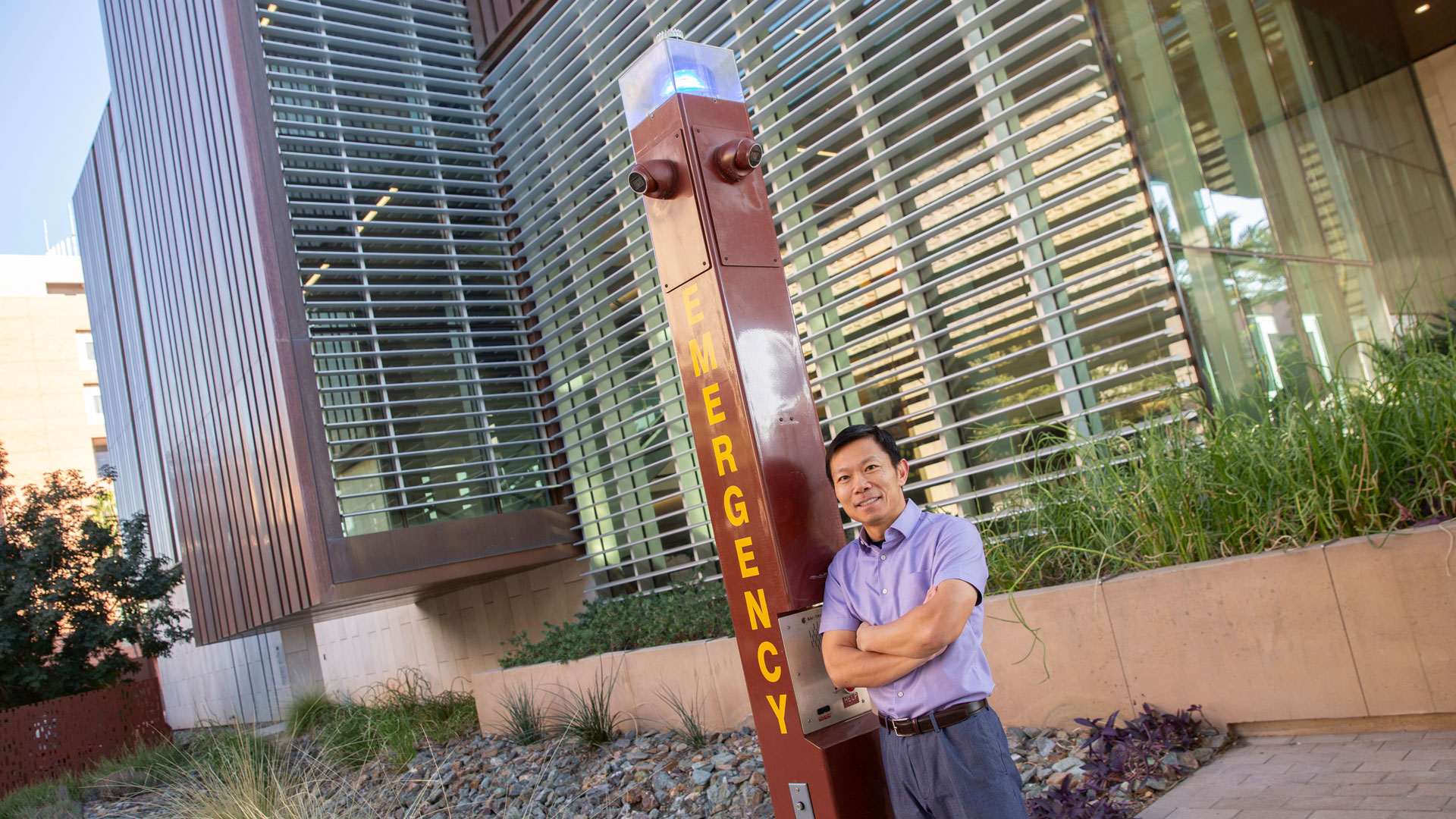
A new campus blueprint
ASU professor integrates smart devices to upscale data collection for a new frontier of computing

The plethora of devices that collect data and engage with the internet, known as the Internet of Things, or IoT, serve as the information highway between users and the physical world.
This up-to-the-minute information collection is possible due to advances in the scale of processing power incorporated by software, hardware devices and data infrastructure across the modern environment.
Cultivating information about activity in a community can improve how people navigate their environment bringing innovation to preexisting infrastructure.
Ming Zhao, an associate professor of computer science at the Ira A. Fulton Schools of Engineering at Arizona State University, received a $500,000 grant from the National Science Foundation, or NSF, to integrate data collection and computing applications into the blue emergency call boxes across ASU’s Tempe campus. Known as the BLUE project, these IoT devices are part of ASU’s effort to scale “smart campus” initiatives.
Zhao and his team plan to establish the BLUE project as a state-of-the-art smart campus cyberinfrastructure to help sustain the growing scale of computing, networking and storage resources at ASU. The smart infrastructure is being built around blue emergency call boxes, which are already located on the campus.
Zhao, who teaches and conducts research in the School of Computing and Augmented Intelligence, part of the Fulton Schools, has a background in cloud and edge computing, machine learning and big data systems. He is collaborating with faculty members in the School of Sustainable Engineering and the Built Environment, also part of the Fulton Schools, and ASU Enterprise Technology to build and integrate this system.
Initially, the devices will collect and process data about environmental conditions and pedestrian traffic enabling members of the ASU community to find the safest travel routes on campus. The research team plans to expand future integrations and is looking for collaborators interested in using their technology.
Smart campuses make smarter students
Smart technology already exists in many classrooms through smartboards, which optimize how educators display information, and classroom lecture recordings so that students can access lectures remotely. Some curriculums are incorporating virtual reality technology to enhance student engagement.
The integration of smart technology strives to ease the inconveniences of daily life by reducing uncertainties such as parking garage wait times, crowd control for special events and tailoring food services to user needs. Smart catering can minimize food waste and smart buildings can reduce energy consumption.
“A smart campus also boosts ASU’s reputation as the most innovative university,” Zhao says. “ASU is a leading institution in smart campus development, and the rich and safe campus experiences that it brings will help attract great talent and investments to ASU.”
A smarter route for collaboration
Zhao says that the true innovation of BLUE is the scale of data processing and learning. For example, devices will have the potential to manage and contribute data to future research opportunities. He notes that the next step for the team is to expand their data collection capabilities by collaborating with other researchers.
For researchers across different domains, a smart campus also provides unprecedented opportunities to use IoT data for new methodologies and discoveries.
“Any field can use IoT data for research, and we welcome them to collaborate with us,” says Zhao, who is also a faculty member in the ASU Global Security Initiative Center for Cybersecurity and Trusted Foundations Affiliates.
Zhao’s team is currently working with transportation researchers on traffic management, traffic light control, work zones and special event management. The team is also exploring opportunities with social science and psychology researchers to use BLUE technology as a solution to manage physical, behavioral and cognitive issues.
Xuesong Zhou, an associate professor of civil and environmental engineering in the School of Sustainable Engineering and the Built Environment, part of the Fulton Schools, assisted in collecting information on local traffic patterns through his work at DemocracyLab. This nonprofit organization connects tech-savvy volunteers to projects that address social, economic, environmental and civic problems.
“Students appreciate the complexity of the changing world,” Zhou says. “They get to see how smart cities should be formed, especially when addressing equity.”
Zhou emphasizes that the benefits of smart technology are most valuable to underserved communities.
Yitao Chen, a computer science graduate student in Zhao’s lab and the lead student developer of the BLUE project, says integrating smart technology into the campus environment is no small task.
“This project is very sophisticated,” Chen says. “We need to process the massive amount of data efficiently using the devices deployed inside each smart pole and share the outcomes with cloud servers. It’s very promising because it will provide ASU additional information for maintenance or decision-making processes.”
Real-time innovation
Because BLUE is not just an application but an infrastructure, it is customized for the ASU community. Its use of edge computing for real-time decision-making can advise users throughout their day. For researchers, BLUE has strong privacy and security protections that will provide safer and easier data collection.
“ASU is ahead of the crowd in this,” Zhao says. “The university leadership has great vision for what we can do, and our faculty are pioneers in this field. Collaboration has been a big part, and we wouldn’t be able to be at this point without all the support we’ve received.”
The technology developed by BLUE can be used to develop other edge applications, such as smart traffic light management and home-based self-managed care for older adults. Depending on its campus-scale success, Zhao says the technology has the potential to be implemented in Tempe on a citywide scale.



































